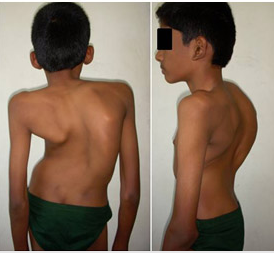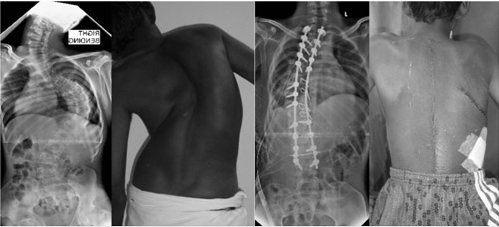Scoliosis Correction Surgery
- Home
- Scoliosis Correction Surgery
Scoliosis Correction Surgery
What is Scoliosis?
Scoliosis is a sideways curvature of the spine that makes the spine look more like an “S” or “C” than a straight “I”. This sideways bending is almost always associated with a rotational component which makes the chest and back prominent on one side.

10-year-old boy with adolescent idiopathic scoliosis
What is the normal curvature of the spine?
The normal spine is curved in the front to back direction with a forward curvature at the neck and the lower back, a backward curvature at the chest and the level of the pelvis. The spine does not have any normal sideways bend.
Why does scoliosis occur?
Scoliosis can occur due to a multitude of reasons Idiopathic – The exact etiology is not known, hence called “idiopathic”. However this is the most common type of scoliosis. Idiopathic scoliosis can run in families.
Congenital – Abnormalities in formation of spinal vertebrae during the fetal stage causes spinal deformity as the child grows. Uneven growth of the vertebrae causes the spine to bend towards one side. For more information on congenital scoliosis follow the link congenital scoliosis.
Neuromuscular – Some children have nerve or muscle diseases that cause spinal deformities, for example polio, cerebral palsy, or myelomeningocele. The uneven muscle pull on the spine cause abnormal curvature.
Could scoliosis have been prevented?
The occurrence of scoliosis cannot be prevented; however the progression of the deformity can be prevented by timely intervention. It should be remembered that scoliosis does not occur because of past sins, consanguineous marriages or carrying heavy school bags.
What are the symptoms of scoliosis?
The deformity when noticed is usually due to the cosmetic disfigurement. Uneven shoulders or waistline, a prominent chest wall on one side, leaning slightly to one side or a hump on one side of the back are the most common findings in a child with scoliosis.
Pain rarely occurs in scoliosis, but it may occur in large curves or curves due to an underlying neurological abnormality .Occasionally long standing severe cases may have difficulty in breathing due to impaired cardiac and chest wall function.
Why do we need to monitor and treat curves?
Adults with moderate or severe scoliosis can have progressively worsening curves which cause cosmetic disfigurement, back pain and in the worst cases, difficulty breathing. Treatment after the curve has already become severe in adulthood is much less successful than treatment during childhood or adolescence. By finding progressive curves early, we hope to keep them from becoming problems in adulthood.

Xrays of a child demonstrating progressive scoliosis. The curve worsened from 30 degrees to 50 degrees in two years
What will the doctor do?
The diagnosis is very easily confirmed by just clinical examination but investigations are necessary to evaluate the severity of the curve and decide on the best treatment.
Primarily, X-rays of the entire spine with standing stretch and sideways bending positions will be taken. Usually, an MRI is part of the evaluation to rule out any birth defects in the spinal cord and nerves. Complex deformities may require a CT scan to visualise the bone configuration

In a child with idiopathic scoliosis, MRI is performed to rule out intra-spinal cord anomalies. In this child, MRI showed extensive syrinx
Following this extensive assessment, the doctor will then decide to treat the condition with bracing or surgery depending on age, severity of curve, underlying disease processes and degree of breathing difficulty.
What are the options of treatment without surgery?
Mild curves (less than 200) just have to be watched till growth maturity (child stops growing) to see if they are progressing. The doctor will want to recheck the curve on a regular basis to see that it is not progressively getting worse. You may be asked to return every 3 to 6 months for re-examination.
Mild to moderate curves (between 250 and 450) which do not appear to be progressing very quickly can be treated with a brace. The scoliosis brace is designed especially for the patient depending on the particular curve. It holds the spine in a straighter position while the patient is growing thus trying to partly correct the curve or prevent it from increasing. A bracing program may help to avoid surgery. The patient will need to wear the brace almost all the time until the end of growth. This will be followed by specific exercises and will require close monitoring by your surgeon.
When do you need surgery?
Surgery is usually required in children with large curves with cosmetic deformity, rapidly progressing curves (even if they are small initially) or when bracing fails to prevent curve progression. Pain or the presence of neurological deficits is other indications for surgery. Your surgeon will decide on whether your child requires surgery.
What type of surgery is done for scoliosis?
There are various surgical options to treat scoliosis. Your doctor will decide the best surgery for your child after taking in to consideration the age of the child, type and severity of the curve and presence of other medical conditions.
The surgical options are
Posterior Fusion
Posterior fusion with instrumentation is the most common operation done for idiopathic scoliosis. In the posterior fusion the spine is operated on from behind with an incision straight down the back. Various types of rods, hooks, wires or screws are used to partially straighten the spine and hold it fast while the bone fusion occurs. For most of these operations on idiopathic scoliosis, a brace is used postoperatively for a few months.

Child with adolescent idiopathic scoliosis treated by posterior corrective instrumentation and fusion.
Anterior Fusion
In the anterior fusion, the spine is operated on from the front, or side. Anterior fusion is used in some special instances of idiopathic scoliosis. An incision is made along a rib and/or down the front of the abdomen to obtain access to the front of the spine. Bone graft from the hip, rib or bone bank is used for the fusion. Screws and washers attached to a rod may be used to straighten the spine.

Child with thoraco-lumbar curve treated by anterior correction and fusion
Anterior and Posterior Fusion
Some special cases of spinal deformity require both an anterior (front) and posterior (back) operation. Usually these can be done on the same day, but sometimes must be done at separate operations spaced 1-2 weeks apart. Following surgery, patients walk with a brace by the fourth to fifth day, and are discharged from the hospital within 10 days. The child can rapidly resume their daily activities. The child can start attending school within 6 weeks in most cases. A return to some sports is possible in 6 to 9 months after surgery

This patient with 120 degrees curve was treated by a combined anterior release and posterior corrective instrumentation and fusion
What are the risks of scoliosis surgery? Is the surgery safe?
As with any surgical procedure, there are general risks and procedure specific risks with spine stabilization surgery. The common general risks of spine stabilization surgery include the risk of adverse reactions to the anesthetic agents, post-operative pneumonia, infection at the site of surgery and blood loss during surgery requiring a transfusion.
The specific risks of spinal stabilization surgery include the risk of injury to the nerves or spinal cord resulting in pain or even paralysis, (the estimated risk of paralysis for major spinal reconstructions is somewhere around 1 in 10,000), the instrumentation breaking, dislodging or irritating the surrounding tissues, and pain from the surgery itself. In our center, intraoperative spinal cord neuromonitoring system (NIMEclipse) is available which gives continuous input to the surgeon about the function of the spinal cord throughout the surgery. This enables safe application of screws into the spine, bony correction and straightening the deformed spine without risks of injuring the spinal cord.

NIM Eclipse intra-operative neuromonitoring system
Why is surgery for scoliosis difficult?
Scoliosis causes the spine to be twisted like a rope and the nerves and cord to be twisted along with it. The correction of such deformity needs accurate implant positioning to facilitate correction and to prevent failure of the rods and screws. Inaccurate screw placement puts the nerve roots and the spinal cord at risk of injury. Overzealous correction can also lead to problems of stretching of the nerves and spinal cord which may lead to temporary or permanent paralysis. This is a surgery to be done by specialists with training in the field of deformity correction.
Surgical Expertise
Testimonials
What Our Patients Say
EXCELLENT rating
Based on 107 reviews My father had rotator cuff problems and needed follow-up care.Dr.Ankith N V was exceptional. They provided thorough, compassionate care and clear communication. The clinic was well-equipped, and attentive Highly recommend.
My father had rotator cuff problems and needed follow-up care.Dr.Ankith N V was exceptional. They provided thorough, compassionate care and clear communication. The clinic was well-equipped, and attentive Highly recommend. RAVINDRA KUMAR2024-06-09Very good Orthopaedic Clinic and Dr Ankith sir well experienced Dr and also clear all the doubts for patients and their families...
RAVINDRA KUMAR2024-06-09Very good Orthopaedic Clinic and Dr Ankith sir well experienced Dr and also clear all the doubts for patients and their families... Dilip Gowda BR2024-05-29I had an outstanding experience with Dr. Ankit at Ankit’s Orthopedic . Dr. Ankit’s exceptional friendliness and professionalism made me feel comfortable and well-cared for throughout my visit. I highly recommend Dr. Ankit for their exemplary patient care and welcoming demeanor.
Dilip Gowda BR2024-05-29I had an outstanding experience with Dr. Ankit at Ankit’s Orthopedic . Dr. Ankit’s exceptional friendliness and professionalism made me feel comfortable and well-cared for throughout my visit. I highly recommend Dr. Ankit for their exemplary patient care and welcoming demeanor. Nikhil L2024-05-29Doctor is so knowledgeable and humble. Also he listens to us keenly and understands the problem. Highly recommended.
Nikhil L2024-05-29Doctor is so knowledgeable and humble. Also he listens to us keenly and understands the problem. Highly recommended. Akshay2024-05-29Good communicate with patients and cooperation well good, we are satisfied your treatment.
Akshay2024-05-29Good communicate with patients and cooperation well good, we are satisfied your treatment. renuka Mallikarjuna2024-05-22Best orthopaedic clinic in vijayanagar good service
renuka Mallikarjuna2024-05-22Best orthopaedic clinic in vijayanagar good service ಬಳ್ಳಾರಿ ನಾಗ2024-05-22Very good doctor and
ಬಳ್ಳಾರಿ ನಾಗ2024-05-22Very good doctor and Kiran S2024-05-18Really...this clinic is too good i recommended Dr.Ankith sir ..and doctor treat very well, he had more knowledge and as well as good human being and his staff is wonderful, this is the perfect place for orthopedic and spine
Kiran S2024-05-18Really...this clinic is too good i recommended Dr.Ankith sir ..and doctor treat very well, he had more knowledge and as well as good human being and his staff is wonderful, this is the perfect place for orthopedic and spine ashoka vc2024-05-17Good service well qualified doctor
ashoka vc2024-05-17Good service well qualified doctor srinath v2024-05-17
srinath v2024-05-17
Book Your Appointment Today!
Call us at 099644 83761 to schedule your visit. Your path to recovery begins at Dr. Ankith’s Orthopedic & Spine Care Clinic. We look forward to helping you achieve your health goals!
